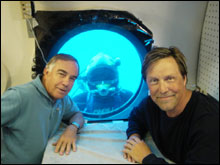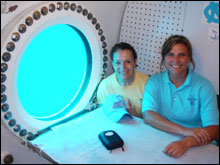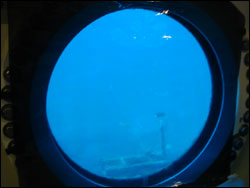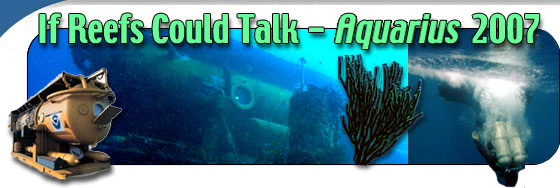Error processing SSI file
|
Mission Log: September 20, 2007
Dr. Chris Martens
Aquarius Aquanaut
 |
|
Jeff Burnside from NBC 4 Miami poses with Aquanaut Chris
Martens before they go LIVE! from Aquarius for an NBC news story to
Miami as well as nationally to MSNBC. (Photo-NOAA National Marine Sanctuary Program)
|
Today was a special day in several ways for our team. We sstarted by teaching our UNC-Chapel Hill courses LIVE from underwater. The classes include my first year seminar entitled "Change in the costal ocean" and Professor Niels Lindquist's "Coastal and Estuarine Ecology." The first course is for freshman students in our Department of Marine Sciences on the main UNC campus in Chapel Hill. The second is taught at UNC's coast laboratory The Institute of Marine Sciences in Morehead City, NC. The Institute and the Department comp[rise UNC-Chapel Hill's Marine Science Program. Our students in both locations were able to watch and listen live as Niels began his reef tour by visiting with Earl, our resident Goliath grouper of the Aquaarius Reef Base habitat located 3.5 mile off Key Largo, in the Florida Keys National Marine Sanctuary.
 |
|
Dr.Sylvia Earle poses with Aquanaut Kate Thompson before
Sylvia and Boyd Matteson film for National Geographic Wild Chronicles. (Photo-NOAA National Marine Sanctuary Program)
|
Advanced technologies for two related mission purposes were used throughout the live broadcast. Those two purposes were: 1) state-of-the-art communications from the sea to the classroom, and 2) state-of-the-art scientific measurements being made continuously on marine sponges. As readers know from our Oceanslive.Org website, we are seeking to better understand the roles of sponges in coral reef ecosystems. Building on excellent research by other scientists we have learned that disturbing sponges by removing them from their natural environment biases experimental results. Therefore we are utilizing the world's only manned underwater observatory, The Aquarius Reef Base, to conductour investigations right on the sea floor. The scientific tools we use include several of the most advanced instruments in the world, among which is an underwater mass spectrometer capable of continuously sensing chemicals being taken up and emitted by sponges. It is frontier science out here int he ocean realm because no one has ever before attempted to utilize this technology in coral reef ecosystems. As you can imagine, we are extremely excited with the success of our mission thus far. As I write this log entry, we are "watching" sponges consume oxygen and release carbon dioxide by watching the mass spectrometer data on a computer connectected into Aquarius. As I look out the viewport in the main lock of Aquarius at a group of fast moving Permit (Trachinotus falcatus) swimming by, I am reminded that it is truly remarkable to get to do such "work" for a living.
 |
|
Aquanaut, Scott Donahue, adjusts the filtration system for
the mass spectrometer. (Photo-NOAA National Marine Sanctuary Program)
|
The teaching and outreach components of our joint mission with our fellow aquanauts from NOAA's National Marine Sanctuary Program are just as fabulous. Students and visitors from wherever internet technology reaches have been able to tune in as we perform our live experiments. The most surprising part of the day came when one of the most famous divers in the world, marine biologist Sylvia Earle paid us a visit while filming a segment with the National Geographic Society. Her group toured our instrument arrays out on the reef then came into Aquarius to photoshoot the interior of the habitat's interior, including our mass spectrometer data live on the computer. What a kick!!
At mid-mission, it has begun to sink in (sorry for the pun) that we have indeed entered a new era of experimental scientific education and outreach. I'll never again be satisfied to simply fly off from Chapel Hill without taking the students with me. Before now only a few could join us in the field...now we'll be taking along everyone who wants to come.
Join us in the coming days as we make new discoveries and explore the exciting costal ocean surrounding Aquarius. Look for opportunities to engage us in live interactions using the chat room, www.nurc.net/aquarius, or simply watch us swim with Earl the grouper, and his littler friends!
|



